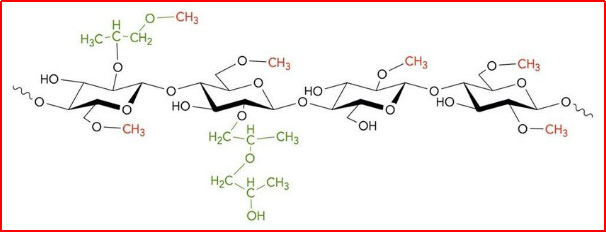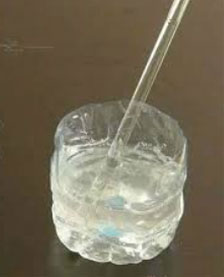Hydroxypropyl methyl cellulose (HPMC) is a modified cellulose ether derived from chemical modification of natural cellulose. It is made by treating cellulose with propylene oxide for introducing hydroxypropyl groups (-CH2CHOHCH3) & subsequently methyl chloride for introducing methyl groups (-CH3).
The manufacturing process of Hydroxypropyl Methyl Cellulose (HPMC) involves several steps to chemically modify natural cellulose to introduce hydroxypropyl and methyl groups onto its backbone. The degree of substitution of these groups can vary, affecting the properties of the resulting HPMC product.


HPMC Gel
The process starts with the selection and preparation of a cellulose source. Common sources include wood pulp or cotton linters. The cellulose is purified and broken down into smaller particles through mechanical or chemical means. Cellulose is a linear polymer of glucose units linked by β-1,4-glycosidic bonds. It forms the structural component of plant cell walls and is composed of repeating anhydroglucose units.
The purified cellulose is treated with an alkaline solution, such as sodium hydroxide (NaOH), to activate the hydroxyl groups present in the cellulose chains. This step prepares the cellulose for subsequent reactions.

Propylene Oxide reacts with the activated -OH groups of cellulose in the presence of alkali catalysts leading to the addition of hydroxypropyl groups (-CH2CHOHCH3) groups onto the cellulose backbone. The degree of substitution (DS) of hydroxypropyl groups can be controlled by adjusting reaction conditions such as temperature, reaction time, and catalyst concentration.
Methyl chloride (CH3Cl) reacts with the -OH groups of both cellulose & newly introduced hydroxypropyl groups, resulting in attachment of methyl groups.
Introduced to the hydroxypropylated cellulose mixture. This further modifies the cellulose structure & imparts additional properties to HPMC. its structure. Like hydroxypropylation, the DS of methyl groups can be controlled through precise control of reaction parameters.
The degree of substitution (DS) of hydroxypropyl & methyl groups on the cellulose chain can be controlled by adjusting reaction conditions such as temperature, reaction time, catalyst concentration, and reactant ratios. The DS values influence the properties of HPMC, including solubility, viscosity, thermal stability, and film-forming ability.
The resulting hydroxypropyl methyl cellulose (HPMC) is neutralized to remove any excess alkali catalysts and then thoroughly washed to eliminate by-products and impurities.
The washed HPMC is dried to remove excess moisture and then milled into fine powder particles. The particle size distribution can be controlled to meet specific product requirements.
The final HPMC powder is packaged under controlled conditions to prevent moisture absorption and maintain product integrity. Quality control measures are implemented throughout the manufacturing process to ensure consistency and adherence to specifications regarding purity, viscosity, and other properties.
Overall, the manufacturing of HPMC involves a series of chemical reactions to modify cellulose and produce a versatile polymer with tailored properties making it unique & suitable for various industrial applications.
Different grades of HPMC are manufactured based on parameters such as viscosity grade, degree of substitution (DS), and particle size.
HPMC is available in different viscosity grades, ranging from low to high viscosity. These grades determine the thickening and gelling properties of HPMC in various applications.
The degree of substitution refers to the average number of hydroxypropyl and methyl groups attached to each anhydroglucose unit in the cellulose chain. HPMC products with different DS values offer different performance characteristics.
HPMC products may also differ in particle size distribution, which can affect dispersibility, solubility, and texture in formulations.
Hydroxypropyl methyl cellulose is a versatile polymer with diverse applications across industries, contributing to improved performance and functionality in various products.